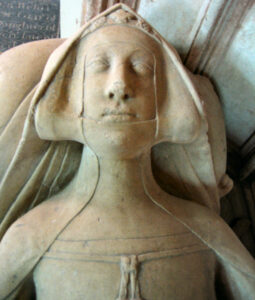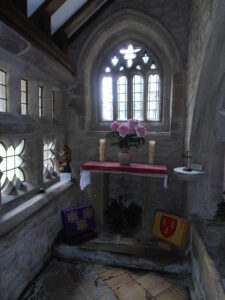Living in Pembridge in the Welsh Marches, enjoying the rural pleasures of pastures, gentle hills and woodland, as well as the eye-catchingly beautiful black and white villages, it is impossible to ignore that this is Mortimer country. Wherever I drive or walk, there are Mortimer relics on all sides.
The most obvious ones are the castles. The ruined glory of Wigmore on its high point, giving dramatic views up and down the main route from north to south.
The vast fortress of Ludlow on the River Teme in the very centre of the town, with all its Mortimer and medieval and Tudor royal connections. The northern outpost of Clun, much ruined but with an impressive keep, and across the border into Powys, the imposing structure of Chirk Castle. All of them have atmosphere; it is quite possible to imagine the long-dead Mortimers walking there, including the heiress Joan de Geneville who owned Ludlow Castle and brought it to the Mortimers with her marriage to Roger Mortimer. I am sure that Joan still climbs to the heights of the great keep when the tourists have gone home.
Churches are good Mortimer fodder to spark inspiration. There is the little church of St Mary the Virgin with its separate bell-tower in Pembridge, where Roger Mortimer and Joan de Geneville were wed at the church door. Once it was much smaller but Roger Mortimer, 1st Earl of March, rebuilt it closer to the size and form that it is today. Also today it contains the tombs of the Gour family who were employed by the Mortimers. Their effigies and those of their wives, give invaluable evidence of medieval clothing. Perhaps this family lived in Pembridge Castle behind the church, where sadly only the moat remains to be seen.
A visit to the church of St Laurence in Ludlow provides us with the great nineteenth century west window with its images of the the Mortimers and their royal descendents of the house of York. Leintwardine, another small church on the River Teme to the west of Ludlow, is where there were once Mortimer chantries built to pray for the family of Roger Mortimer, sadly now obliterated but still a place steeped in Mortimer memories.
Sadly Wigmore Abbey suffered from the Dissolution of the Monasteries of Henry VIII and no longer gives a home to the Mortimer tombs, unless they are under the grassy surround. But a trip to the east to Much Marcle takes in the church of St Bartholomew where Blanche Mortimer, Lady Grandison, daughter of Roger and Joan, lies for ever at peace in her transparent veiling on her magnificent tomb.
Battlefields cannot be ignored. The fields at Mortimer’s Cross are where the battle was won by a direct Mortimer descendent, Edward, Earl of March, later King Edward IV, when he was still a youth of eighteen years. His father was Richard Duke of York, son of Anne Mortimer’s marriage to Richard of Cambridge. It is easy to imagine the two forces of York and Lancaster lined up against each other in this quiet corner of the marches, and the chantry chapel ordered by King Edward to pray for the dead in nearby Kingsland Church.
It would be impossible for me not to find an interest in this family that dominated the Welsh Marches in the Middle Ages. And then there are the Mortimer characters themselves, with all their widespread ambitions, the often tragic consequences of their political choices, and their important marriage alliances. It was merely a question of which Mortimer to bring to life in a novel.
In fact, my choice was not a difficult one, since I find the women in powerful families of prime importance. Medieval women are for the most part invisible other than as wives and sisters and daughters. History is invariably written by the chroniclers, men who had little interest in the role of women. Surely some of them, intelligent, well-informed and generally clever women, played a major part in their family history, and even sometimes in royal Court circles. There are gems of history waiting to be discovered and used in historical fiction. We know more about them than we think, and they deserve to be brought onto centre stage.
With this in mind, I found it impossible not to write about Joan de Geneville, the heiress wife of the notorious 1st Earl of March.
Thus A Court of Betrayal was born.






